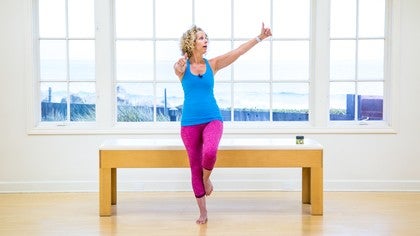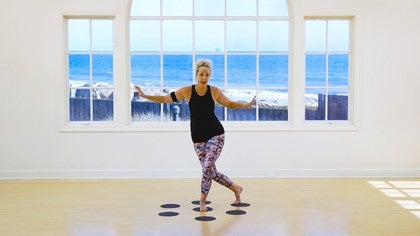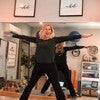Description
About This Video
Transcript
Read Full Transcript
Hi everyone, my name is Erika Quest. I'm super excited to be here today. I'm going to give you a little active aging tutorial. A little bit about me, I'm from Southern California, I've been in the Pilates functional fitness industry for over 12 years now. I have a studio down south in Laguna Beach, California and I'm super passionate about the active aging market.
We're going to talk a little about that momentarily but my background with active aging is I am a level one certified mobility and stability specialist through BOSU. I also develop the curriculum for the second iteration of all of that work and I also work and have been certified through the Functional Aging Institute. So hopefully those are some good resources for you. The active aging market, as you may or may not know, is 50+ and this content, where I'm going to be talking to you about, is geared towards the independent exerciser. So in the 50+ market there is a dependent exerciser and independent exerciser and then also a elite level exerciser.
So the independent exerciser is somebody who can wake up in the morning, perform all of their activities of daily life unassisted. Now, within the confines of the independent exerciser we're dealing with a heterogeneous group of people. No two people are the same. You might have someone who is 57 years old and has already had a knee replacement or maybe a hip replacement. You also might have somebody whose 57 years old who still an elite level or at least doing triathlons or competing at tennis regularly.
So I say this because no strategy is going to be the same for every body. But the American Counsel on Exercise has given us some protocol. So whether you are an active ager yourself or whether you're an instructor who teaches an active ager; I hope that some of these concepts, protocols, and strategies will be worth while to you. First and foremost, when we're doing assessment and alignment of doing a new intake for a client and or if you are an active ager, there are specific things that we should be also taking a look at when we are analyzing what's happening in our bodies or our client's bodies. As a for instance, strengthening of the tibialis anterior or the front of the shin muscles is incredibly important.
So let's talk a little about that. In a standing position, it's really easy to add tibialis anterior or dorsiflexion of the feet into our assessment and our alignment. This offers us as instructors or you as an active ager, the opportunity to see how your mobilization at your ankle joint is. It's just as simple as maybe just doing a heel tap on the floor and each foot might feel a little bit different and that's okay. There's nothing wrong with that.
One foot as you tap out or your client taps out, may evert out to the side. That's something to take note of. All of these are common imbalances and common problems that can be definitely worked on from a measurable standpoint to help with fall prevention and reaction time. The tibialis anterior for the active aging population is a critical area of the body because what we do not want to see as we all actively age is what is unfortunately called the senior shuffle. Right? We want to have active tibialis anterior so that we can walk up the stairs, get out of the car, perform any activities of daily life.
Or maybe go and play a game of golf or a game of tennis and do all of that in a very very healthy and active way. Another thing that we want to think about with active agers as far as assessing them is their quadratus lumborum strength. This is another deep stabilizing muscle of the trunk that really helps, decompress isn't necessarily the right term, but it really helps support and stabilize the lumbar spine. And if you have good intra abdominal pressure happening involving the transverse abdominis, the quadratus lumborum, the diaphragm and the pelvic floor, or stability core if you will, you're going to really help your client or you stay out of low back pain. So one of the ways I like to just tell a fun story about the transverse abdominis here is that, do this with me.
Place your fingertips on your low belly. I want you to imagine that you're my best friend and wherever you're at right now I took you out for the best breakfast ever and you chose to have the three egg omelet and you chose to have the toast and you chose to have the hash browns and you had the coffee and the orange juice and if you're gluten free, we accommodate for those allergies so your toast was even gluten free because I'm your best friend. Now what I want you to do is I want you to let your breakfast hangout in your hands (exhales). It doesn't feel good and it certainly doesn't look good. But one of the best things that you can do to activate your stability core is to get that transverse abdominis fired up.
So I'm your best friend, we're getting in the car together and I need you to put your seatbelt on because I have to drive you safely back home. So do this with me, take a nice deep drink of air in (inhales) and on that exhale I want you to flatten, put that seatbelt on and really feel that transverse abdominis. If I came around and I touched you right here, something should be happening. This is a critical part of our stability core along with as I mentioned the quadratus lumborum, as well as the diaphragm and your pelvic core. So this is a great way that you as an active ager or you as an instructor can also see what's happening and add that into your assessment tools.
Finally as far as assessing strength, lower body comes into play here as well. Often times with the 50+ we're dealing with people who have arthritic joints, people who have possibly had joint replacements. And in this capacity lower body strength and power becomes critical specifically the hamstrings and the gluteal muscles come into play here. One of the things that we will often times see is an area of the body that is misfiring unilaterally and you can easily and pretty much with your naked eyes see this if you have somebody get down and do some unilateral bridging. So I would ask you or my client to lie down onto their backs, feel the back of the body as you press the arms down into the floor or the mat.
Put your feet still about the hip with distance position parallel so north south to the best of your ability and what you can feel in your own body. And remember there's no judgment here so don't judge yourself. And from here I just want you to simply lift up into a neutral bridge position. Now we talked about that stability core before, it is also still at work in this neutral bridge because I'm just lifting and lowering my pelvis. But now I'm going to ask you to transfer weight to one of your legs.
Load the leg and lift the other one so you're in a unilateral position. And common imbalances that are gonna happen are a dip of one hip. This is an easy way for you to automatically see or feel which side might be your strong side and which side might be your smart side. And your smart side, I call your lazy side because your smart side has basically been cheating on you your whole entire life. But guess what? You can bring things back to a more symmetrical place if you're addressing all of these things.
This is a great way if you look at those 3 things to measure yourself, measure your clients and then apply some of the exercises in your studio or your environment so that you can strengthen those areas and really help with fall prevention and reaction time longterm. Because as an active ager, that's really what it's all about. So let's talk a little bit now about general workout protocol. And this comes from the American Counsel on Exercise. There are several things that I could talk to you about here but I'm gonna go briefly through a few that are pretty critical.
The first one is because of what I mentioned earlier, knee replacements, arthritic joints, no more than two and a half minutes down on your knees at one given time. Now I know what you're thinking. You're like what Erika, I can only do like two and a half minutes on my knees? No you can certainly come back to it but after you've been down for about two and a half minutes, transition into a different body position which I'll talk about next and then move them back into a kneeling or quadruped position or yourself back into a kneeling or quadruped position at a later time. So that's completely fine, this does not nix any of the kneeling work on the reformer or the trapeze table if you're training in a Pilates specific environment and it certainly doesn't limit you getting down onto the floor on your knees.
Be nice, make sure the knees are padded if need be and take precautions in those areas. Now let's talk about training the body. A whole body varied program should involve all six body positions. Now the American Counsel on Exercise talks about this from an active aging standpoint but it really can be applied across the board, right. So what are all six of those body positions?
We're talking about standing, sitting, kneeling, side sitting or side lying, supine on your back and also prone. So those are your six body positions. And when you're creating a general workout for yourself or in your fitness space, if you will, you want to make sure that you're addressing all of those body positions. Now here's the deal. One of the misnomers, especially when it comes to balance, is that balance only needs to be trained in standing.
But in fact if you can accomplish balance strategies in more than just that standing position, you're also going to really help with fall prevention and reaction time. In balance strategies with standing, what I like to think about, just simply is just to start to do a single leg balance and notice where you and or your client is in this position. Look at the foot, look at the tree trunk leg, the stability leg, notice what's happening. And then have yourself or have them switch sides and if this is looking or feeling pretty easy then how can you change this and progress this for yourself or regress this. First of all the regression would just be to barely lift a toe.
The progression here would be to add in a sense of proprioception and or visual affect. So come back into that single leg stand and now see if you can suddenly dim your eyes and notice what happens. You may have a little shimmy shake in those writing response muscles. The same thing may ring true when you are doing some visual affect. And what do I mean by that?
Well, give me a thumbs up and try to take one of your thumbs up and to the left or right and look at it and notice what happens in your body or your client body. Now these simple strategies should be also a part of a varied program. Another recommendation from the American Counsel on Exercise and don't panic if you're an instructor is to really try to limit the time doing supine work on your back. And if you're watching this as an instructor you're going oh my gosh Erika I do so many exercises on the back and so do I and that's okay. But I'm asking you to think about that and how can you get creative by bringing some of those supine exercises, whether it be on the mat, the reformer, the trapeze table and bring them into standing or maybe in more of a supine incline position.
This could be as simple as adding a stability ball, a Pilates arc if you're at home, maybe padding yourself up with a couple of pillows behind your back. So that when you perform a chest lift, that you're not all the way flat down on your back. That would be a great way to bring the core, not all the way off the floor, but at least getting there. Now to take maybe some of the things all the way up to standing. Is there a way that you can actually teach some core integrated exercises off the floor, yes you can.
You can easily do it standing with no props at all. Why can't you just stand up as tall and find your axial elongation and not even need in to add inflection. But right adding in that percussive breath of the hundreds or perturbation of the arms and starting to see what fires up in your trunk integration. Something should be happening and sometimes maybe you actually want to start there before you take them onto the floor. Because you know that they're going to be activating the proper muscles to actually perform the exercise well.
Couple of final things I want to mention here. Again from the American Counsel on Exercise, and this research is actually quite recent within the last 15 years is what you're getting from me right now. Is that when you're working with an active ager that's doing rotation which is a wonderful thing, right we all need to rotate in life. But if you're dealing with someone who struggles with rotation and or maybe has some vestibular issues, make sure that they're just moving their cervical spine a little bit slower and that's the generalized recommendation when it comes to the active aging population. But as I mentioned, we're dealing with the heterogeneous group so no two people are different.
Just keep that in mind when you're dealing with all those snowflakes out there that are either yourself or your clients. Finally, let's talk about feet just briefly. So hands and feet often times become stiff or arthritic or maybe there's some peripheral neuropathy going on. And I know that a lot of people get physical therapy which is great and well and fine that tells them to maybe roll up a towel with their toes or roll up a washcloth or maybe pick up some marbles. All of those are great great ideas.
I cam up with one that's just a little bit more fun and I wanted to share it with you. So maybe you've seen this sitting off in the distance this whole entire time. This is just a great retro game that I remember from my childhood. It is a super ball and 10 jacks. And I just so happen to have a container with this set.
If you don't have the container, grab a glass just grab a bin of some kind. A great way to get people to articulate their feet and move their toes, their tarsals, their metatarsals. Is to play a game of ball and jacks. Now don't worry you don't have to drop the super ball. We'll talk about that in a moment.
But you do need to drop the jacks. So drop out those 10 jacks. Now the more progress version of this would be to do it in standing. The more regress version would just be to put yourself or your client down in a chair. And what I task myself or my client to do is to actually physically pick up all of these jacks, come to a single leg balance, stand and drop them in that bin.
Can you see? This is challenging just for me to do this. Having to use visual affect, I'm having to balance on a single leg, I'm having to articulate with my feet. I usually have them start with one foot and use their foot to do this on one side, spill out the jacks, do it again over on the other foot and they get to finish with their reward. The smallest but really really nice way to get some self massage through the feet with the super ball. So it's really two tools in one because now you have this nice little ball that you can just take the time to roll through the medial arch of the foot, the inside arch of the foot if you will, and you can do that as many times as you like or feel good for you.
The general rule here is that as you pass through the foot the pain should, not the pain but the delicious discomfort if you will should get better versus worst. And you want to make sure you give a nice little self massage of the tissue on the base of that foot. It's the cheapest massage that you can give yourself, right? And you want to make sure you also hit the transverse arch. You have three arches; the medial line, the lateral line, the outside and your transverse.
And once you've done that you can certainly switch to the other side. And notice how your feet feel incredibly different just after a couple minutes of involving that strategy. Thank you so much for watching. I hope some of these procedures and protocols will make it into your life and into your studio life if that's where you're teaching and that you'll take this along with your active agers and maybe yourself for better activities of daily life and stay awesome.
The Teacher's Corner: Improving Balance
Comments
I teach a balance class at a Cancer center in San Jose as well as own a private Pilates studio. My client base is primarily over 50 active agers. (Definitely adopting that phrase!) I would love to take a workshop with you. Please add me to your email list for upcoming training. Love your style and appreciate your expertise. Sally
You need to be a subscriber to post a comment.
Please Log In or Create an Account to start your free trial.




















